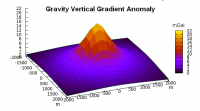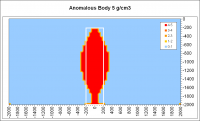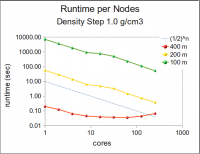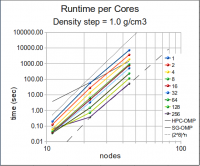GIM
From HP-SEE Wiki
General Information
- Application's name: Geophysical Inversion Modelling
- Application's acronym: GIM
- Virtual Research Community: Computational Physics
- Scientific contact: Neki Frasheri
- Technical contact: Neki Frasheri, nfrasheri@fti.edu.al
- Developers: Center for R&D on IT and Department of Computer Engineering, Faculty of Information Technology, Polytechnic University of Tirana, Albania
- Web site: http://itc.upt.al/
Short Description
Calculation of best approximation of geological structures using the Monte-Carlo method combined with iterative best approximation effort algorithm. The number of 3D spatial points may reach 500 M or more. Searching of best approximation points iteratively requires considerable processing power. The planned work aims to run the inversion algorithm in parallel systems and evaluate rates of convergence and of error for different iteration parameters. As first step the gravity field will be considered, with objective to repeat it for natural magnetic and electric fields. This would serve as basis for dealing more complex problems as induced currents (resistivity method) and induced polarization.
Problems Solved
Interpretation of data from geophysical surveys. Actual version of the software covers only gravity anomalies.
Scientific and Social Impact
Improvement of geophysical interpretation methods and of regional cross-disciplinary collaboration.
Collaborations
Research units involved in geophysical problems:
- Center for R&D on IT
- Department of Computer Engineering
- Academy of Sciences of Albania
- Faculty of Geology and Mining
Beneficiaries
Research units involved in geophysics
- Academy of Sciences of Albania
- Faculty of Geology and Mining
- Geological Service
- Other organizations dealing with interpretation of geophysical data
Number of users
4
Development Plan
- Concept: pre-project
- Start of alpha stage: pre-project
- Start of beta stage: M4
- Start of testing stage: M8
- Start of deployment stage: M20
- Start of production stage: M24
Resource Requirements
- Number of cores required for a single run: up to 1024
- Minimum RAM/core required: 2 MB/core
- Storage space during a single run: 2 GB
- Long-term data storage: -
- Total core hours required: 5000
Technical Features and HP-SEE Implementation
- Primary programming language: C
- Parallel programming paradigm: OpenMP + MPI
- Main parallel code: C
- Pre/post processing code: C
- Application tools and libraries: standard C
Usage Example
Infrastructure Usage
- Home system: HPCG
- Applied for access on: 20 Jan 2011
- Access granted on: 3 Feb 2011
- Achieved scalability: 12 cores (OpenMP)
- Achieved scalability: 256 cores (MPI)
- Accessed production systems:
- BG Blue Gene/P
- Applied for access on: 14 Jun 2011
- Access granted on: 20 Jun 2011
- Achieved scalability: ... cores
- Pecs SC
- Applied for access on: 5 Sep 2011
- Access granted on: 21 Sep 2011
- Achieved scalability: 1024 cores (OpenMP)
- Achieved scalability: 256 cores (MPI)
- Porting activities: yes
- Scalability studies: yes
Running on Several HP-SEE Centres
- Benchmarking activities and results:
- GIM version OpenMP runs in HPCG of IICT-BAS (using 1 - 16 virtual cores) and in Pecs SC, NFII Hungary (using 1 - 1024 cores). Runtime for different model sizes is carried out in both resource centers
- GIM version with MPI runs in HPCG of IICT-BAS and in Pecs SC, NFII Hungary (using 1 - 256 cores). Runtime for different model sizes is carried out.
- Other issues:
Achieved Results
- Testing of OpenMP version for up to 1024 cores.
- OpenMP Runtime and convergence compared for problems with different sizes.
- Tests with field data carried out.
- Testing of MPI version for up to 256 cores
- MPI Runtime and convergence compared for problems with different sizes.
- Modifications of the inversion iterative algorithm.
- Analysing the effect of variations in the error formula used for finding the best 3D node in each iteration
- The impact in runtime and error of formula variations is evaluated for single body and two body mdoels
- Ongoing activity
- Testing the application with field data using variations of parameters
Publications
- Papers
- N. Frasheri, S. Bushati. An Algorithm for Gravity Anomaly Inversion in HPC. SCPE: Scalable Computing: Practice and Experience vol. 13 no. 2, pp. 51-60 (http://www.scpe.org/index.php/scpe).
- N. Frasheri, B. Cico. Analysis of the Convergence of Iterative Geophysical Inversion in Parallel Systems. Springer Advances in Intelligent and Soft Computing 150: ICT Innovations 2011 (ed. L. Kocarev). Springer-Verlag 2012
- Proceedings
- N. Frasheri, B. Cico. Reflections on parallelization of Gravity Inversion. HP-SEE User Forum, 17-19 October 2012, Belgrade, Serbia.
- N. Frasheri, B. Cico. Scalability of geophysical Inversion with OpenMP and MPI in Parallel Processing. ICT Innovations 2012. 12 – 15 September, Ohrid, Macedonia.
- N. Frasheri, B. Cico. Convergence of gravity inversion using OpenMP. XVII Scientific-Professional Information Technology Conference 2012, 27 February - 2 March 2012, Žabljak Montenegro
- N. Frasheri, S. Bushati. An Algorithm for Gravity Anomaly Inversion in HPC. SYNASC 2011 - 13th International Symposium on Symbolic and Numeric Algorithms for Scientific Computing, September 26-29, 2011, Timisoara, Romania
- N. Frasheri, B. Cico. Analysis of the Convergence of Iterative Gravity Inversion in Parallel Systems. ICT Innovations 2011 Conference, Macedonian Academy of Sciences and Arts (MANU), Skopje, 14-16 September 2011
- Presentations
- N. Frasheri, S. Bushati, A. Frasheri. A Parallel Processing Algorithm for Gravity Inversion. Accepted in Geophysical Research Abstracts, Vol. 15, EGU2013-8739, 2013, EGU General Assembly 2013
- N. Frasheri, B. Cico. Computing developments in Albania and it’s applications. International Workshop on recent LHC results and related topics. 8-9 October 2012, Tirana, Albania
- N. Frasheri. HP and High Performance Computing in Albania. HP Solutions Event, 26 Septemebr 2012, Tirana Albania
Foreseen Activities
- Testing of the algorithm with field data
- remains an open activity during the project and afterwards
- Modifications of the inversion iterative algorithm.
- parallelization of Monte Carlo approach for the inversion



